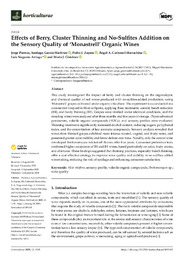Por favor, use este identificador para citar o enlazar este ítem:
https://hdl.handle.net/11000/37853Registro completo de metadatos
| Campo DC | Valor | Lengua/Idioma |
|---|---|---|
| dc.contributor.author | Piernas, Jorge | - |
| dc.contributor.author | García Martínez, Santiago | - |
| dc.contributor.author | Zapata, Pedro J. | - |
| dc.contributor.author | Carbonell Barrachina, Ángel A. | - |
| dc.contributor.author | Noguera Artiaga, Luis | - |
| dc.contributor.author | Giménez, María J. | - |
| dc.contributor.other | Departamentos de la UMH::Biología Aplicada | es_ES |
| dc.date.accessioned | 2025-11-04T11:46:10Z | - |
| dc.date.available | 2025-11-04T11:46:10Z | - |
| dc.date.created | 2025-09 | - |
| dc.identifier.citation | Horticulturae 2025, 11(9), 1105 | es_ES |
| dc.identifier.issn | 2311-7524 | - |
| dc.identifier.uri | https://hdl.handle.net/11000/37853 | - |
| dc.description.abstract | This study investigated the impact of berry and cluster thinning on the organoleptic and chemical quality of red wines produced with no-sulfites-added production, using ‘Monastrell’ grapes cultivated under organic viticulture. The experiment was conducted in a commercial vineyard in Murcia (Spain), applying three treatments: control, bunch reduction (BR), and berry thinning (BT). Grapes were vinified under identical conditions, and the resulting wines were analyzed after three months and five years of storage. Physicochemical parameters, volatile organic compounds (VOCs), and sensory profiles were evaluated. Thinning treatments significantly increased alcohol content, reducing sugars, polyphenol index, and the concentration of key aromatic compounds. Sensory analysis revealed that wines from thinned grapes exhibited more intense toasted, vegetal, and fruity notes, and presented greater color stability and fewer defects over time. Notably, only the control wine developed Brettanomyces-related off-flavors after five years. Consumer preference tests confirmed higher acceptance of BR and BT wines, based particularly on color, fruity aroma, and aftertaste. These findings suggested that thinning practices, especially bunch thinning, offer a cost-effective strategy to improve wine quality and stability in no-sulfites-added winemaking, reducing the risk of spoilage and enhancing consumer satisfaction. | es_ES |
| dc.format | application/pdf | es_ES |
| dc.format.extent | 14 | es_ES |
| dc.language.iso | eng | es_ES |
| dc.publisher | MDPI | es_ES |
| dc.rights | info:eu-repo/semantics/openAccess | es_ES |
| dc.rights | Attribution-NonCommercial-NoDerivatives 4.0 Internacional | * |
| dc.rights.uri | http://creativecommons.org/licenses/by-nc-nd/4.0/ | * |
| dc.subject | Vitis vinifera | es_ES |
| dc.subject | sensory profile | es_ES |
| dc.subject | volatile organic compounds | es_ES |
| dc.subject | Brettanomyces sp. | es_ES |
| dc.subject | wine quality | es_ES |
| dc.title | Effects of Berry, Cluster Thinning and No-Sulfites Addition on the Sensory Quality of ‘Monastrell’ Organic Wines | es_ES |
| dc.type | info:eu-repo/semantics/article | es_ES |
| dc.relation.publisherversion | https://doi.org/10.3390/horticulturae11091105 | es_ES |

Ver/Abrir:
horticulturae-11-01105 Jorge Piernas 2025.pdf
257,24 kB
Adobe PDF
Compartir:
 La licencia se describe como: Atribución-NonComercial-NoDerivada 4.0 Internacional.
La licencia se describe como: Atribución-NonComercial-NoDerivada 4.0 Internacional.
.png)